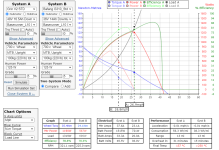Williemakeit
1 mW
- Joined
- Nov 14, 2021
- Messages
- 18
Hey all, I'm looking for some advice for converting my Surly Disk Trucker to electric assist. Grin and others who only sell hub motors seem to think mid-drive systems are not good. However I can't get over the advantages of a mid-drive so I have a hard time ruling them out.
Here's my situation:
- 2019 all steel Surly Disk Trucker as is weighs in at 32.4 lbs. My weight is 180 lbs.
- Assuming hub or mid + battery will put bike @ 50 lbs. (+/- 2), so total e-bike and rider weight is 230 lbs.
- Triple in front 48-36-26 and 10 speed cassette 11-36...so plenty of gears.
- Prefer to keep as light as possible since I want to use as much human power as possible.
- Don't need any assistance on flats, mostly looking assistance for 5-7% grades that can be from 2-8 miles.
- I plan to contribute 120 watts of human power when climbing hills.
- Would like 60 mile range. Keep in mind any given ride would have 50% up and 50% down.
What is the best solution for Motor:
Mid drive 750 watt motor looks to give best weight to power ratio and should have plenty of power/hear dissipation.
Hub drive, looking at the Grin line up:
G310/G311 Bafang seems under power for long inclines.
Shengyi SX, not sure.
eZee, GMAC Grin All Axel, probably OK, but not sure if they would be better than the Bafang BBS02 mid-drive.
Controller: Which would give the best automated solution to only giving assistance on hills?
Eggrider - for Mid-drive - could be programmed to only kick in during lower RPM's. This assumes cadence would slow down as I started to climb. iPhone app is very appealing. Might not work with some hub motors systems.
Grin Cycle Analyst - With hub motor and torque sensor it could be programmed to only kick in after I exceed 120 watts human power.
I'm not expecting answers to all questions, but chime in on anything you have experience with. Thanks
Here's my situation:
- 2019 all steel Surly Disk Trucker as is weighs in at 32.4 lbs. My weight is 180 lbs.
- Assuming hub or mid + battery will put bike @ 50 lbs. (+/- 2), so total e-bike and rider weight is 230 lbs.
- Triple in front 48-36-26 and 10 speed cassette 11-36...so plenty of gears.
- Prefer to keep as light as possible since I want to use as much human power as possible.
- Don't need any assistance on flats, mostly looking assistance for 5-7% grades that can be from 2-8 miles.
- I plan to contribute 120 watts of human power when climbing hills.
- Would like 60 mile range. Keep in mind any given ride would have 50% up and 50% down.
What is the best solution for Motor:
Mid drive 750 watt motor looks to give best weight to power ratio and should have plenty of power/hear dissipation.
Hub drive, looking at the Grin line up:
G310/G311 Bafang seems under power for long inclines.
Shengyi SX, not sure.
eZee, GMAC Grin All Axel, probably OK, but not sure if they would be better than the Bafang BBS02 mid-drive.
Controller: Which would give the best automated solution to only giving assistance on hills?
Eggrider - for Mid-drive - could be programmed to only kick in during lower RPM's. This assumes cadence would slow down as I started to climb. iPhone app is very appealing. Might not work with some hub motors systems.
Grin Cycle Analyst - With hub motor and torque sensor it could be programmed to only kick in after I exceed 120 watts human power.
I'm not expecting answers to all questions, but chime in on anything you have experience with. Thanks



